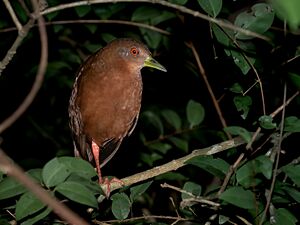Uniform crake facts for kids
Quick facts for kids Uniform crake |
|
|---|---|
 |
|
| Amaurolimnas concolor | |
| Conservation status | |
| Scientific classification | |
| Genus: |
Amaurolimnas
|
| Species: |
concolor
|
 |
|
| Synonyms | |
|
|
The uniform crake (Amaurolimnas concolor) is a type of bird. It belongs to the rail, crake, and coot family, called Rallidae. You can find this bird in Mexico, most of Central America, and in nine countries in South America.
Contents
About the Uniform Crake
What's in a Name?
Scientists first described the uniform crake a long time ago. They have changed its scientific group, or genus, a few times. Now, it is the only bird in its current group, Amaurolimnas.
There are two types, or subspecies, of uniform crake alive today. One is called A. c. guatemalensis. The other is A. c. castaneus. Sadly, a third type, the Jamaican wood rail (A. c. concolor), used to live only in Jamaica but is now extinct.
What Does It Look Like?
The uniform crake is about 20 to 23 cm (7.9 to 9.1 in) long. It weighs around 95 to 130 g (3.4 to 4.6 oz). Male and female crakes look very similar.
They have a medium-sized bill that is yellowish-green. Their eyes are red, and their legs and feet are pinkish-red. The A. c. guatemalensis type is larger. It has olive-brown feathers on its back and brown feathers underneath. The A. c. castaneus type also has olive-brown backs. But its belly feathers are a reddish-brown color.
Where Uniform Crakes Live
The uniform crake lives in many different places, far apart from each other. The A. c. guatemalensis type is found from southern Mexico through Central America. This includes places like Veracruz and Oaxaca. It also lives in western Colombia and northwestern Ecuador.
The A. c. castaneus type lives in northern Venezuela and the Guianas. You can also find it in several parts of Brazil, both inland and near the coast. It is also in eastern Ecuador, Peru, and some areas of Bolivia.
Their Home Environment
These birds like many kinds of wet or slightly dry places. They live in wooded swamps and flooded forests. They also like ravines and streams with lots of plants. You might see them in thick plants at the edge of secondary forests or farm areas. They can live from sea level up to about 1,000 m (3,300 ft) high.
Uniform Crake Behavior
Movement and Travel
Scientists don't know much about how the uniform crake moves around. It is not known if they travel long distances or stay in one place.
What Do They Eat?
The uniform crake usually looks for food hidden in plants. It searches through fallen leaves and other natural bits on the ground. It also digs in mud with its bill. Their diet includes earthworms, insects, and spiders. They also eat small amphibians, lizards, seeds, and berries.
Reproduction and Family Life
We don't know much about when uniform crakes have their babies. In Costa Rica, they are known to breed in July. It is thought that they protect their own area during this time.
One nest found in Costa Rica was in a swampy forest near a stream. It was a cup-shaped nest made of leaves. It was built on top of a tree stump covered in vines. This nest held four eggs.
Sounds and Calls
The uniform crake's song is a series of 6 to 20 whistling sounds. These whistles go up in pitch, sounding like "tooee." Pairs of crakes talk to each other with clear, soft "tooo" notes. When they are alarmed, they make a sharp, nasal sound like "kek."
Status of the Uniform Crake
The IUCN (International Union for Conservation of Nature) says the uniform crake is a species of "Least Concern." This means it is not currently in danger of disappearing. It lives across a very large area. We don't know exactly how many there are, but their numbers seem to be going down.
No big threats have been found right now. Even within the areas where it lives, you might only find them in certain spots. Because these birds are very shy and hard to see, they might be living in more places than we know. However, losing their forest homes definitely hurts them.


